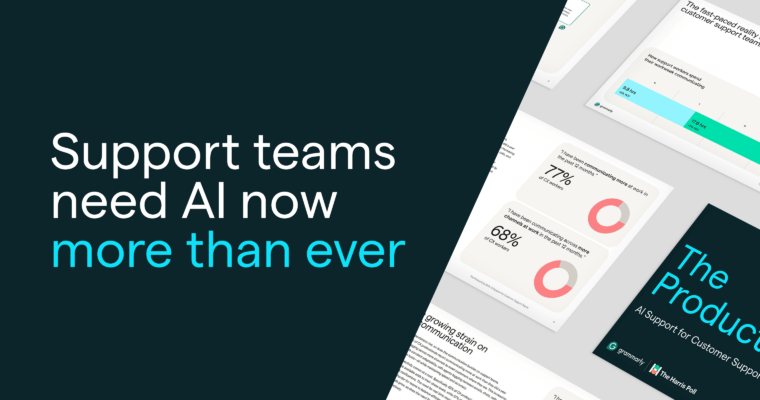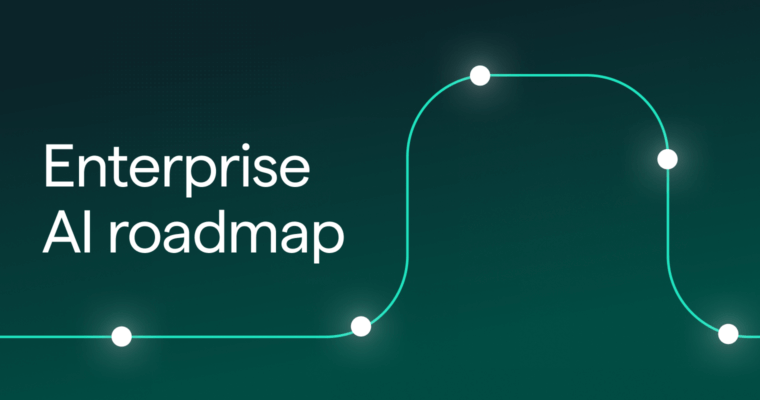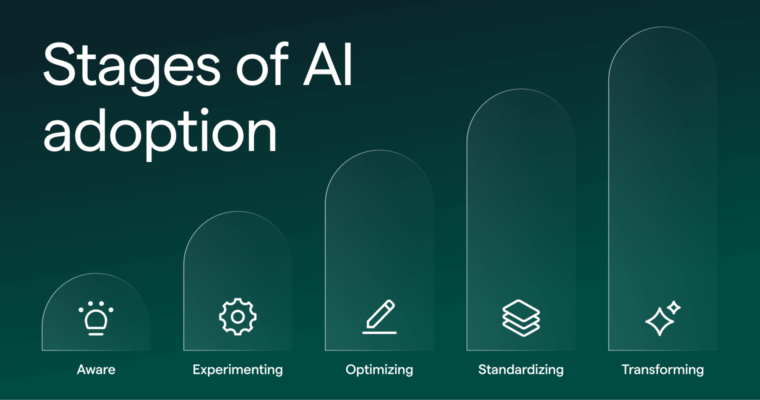Artificial intelligence (AI) has the potential to drastically transform nearly every area of your business. This isn’t news. Soon, the integration of AI will no longer be an option for businesses but a necessity. Some might find this daunting. But innovative companies and professionals have already been using AI to reshape work.
AI stands out for its ability to transform business communication by automating and enhancing manual and time-consuming communication tasks. AI can help companies accelerate high-quality content production, gain new insights, scale personalized customer outreach, and enhance overall communication quality. AI isn’t just a technological upgrade. It’s a fundamental shift in how employees communicate and how businesses operate. It’s the new language of business.
The benefits of being fluent in this language are significant. Knowledge workers using AI say it increases their productivity, reduces stress, and lightens their workload. Leaders tout similar benefits for their business, including saved costs, faster pace of innovation, and increased quality of service.
However, your organization will only realize the benefits of AI if all of your employees are equipped to use the technology. Until everyone is empowered to “speak the same language” of AI, you’ll only see limited success—and right now, the majority (78%) of workers say they want to learn how to use AI more effectively for their jobs.
Read on to learn the fundamentals of AI literacy across the enterprise and its importance in transforming your business.
Understanding AI literacy gaps across the enterprise
Before we dive in, it’s important to start with the fundamentals. The (near) future workplace will be one in which every employee’s unique skill set will be augmented by artificial intelligence. While some may fear or resist this new technology, the reality is that machines will not replace knowledge workers—instead, they will enhance, automate, and make our lives easier. But this is possible only if every employee can proficiently use AI tools to capture their full potential.
Every employee at your company is likely in a different phase of AI literacy. If your company aims to continue on its path of AI adoption, it’s critical to start by ensuring your workforce has an equitable AI skillset. Here are four key AI literacy definitions that describe where someone may be in their relationship with AI at work:
- AI avoidant: They choose not to interact with AI tools at work.
- AI familiar: They experiment with AI at work.
- AI literate: They use AI comfortably in their daily work.
- AI fluent: They are using AI in advanced ways that many others are not; also referred to as “power users.”

According to Grammarly’s annual report, The Productivity Shift: From Overwhelm to AI Empowerment, 39% of knowledge workers report using AI at work regularly. Of this group, only 13% identify themselves as AI fluent while 26% are AI literate. The largest cohort (39%) consider themselves AI familiar, meaning that they have experimented with AI but are not yet using it as a part of their daily work, while 22% still avoid AI altogether.
Regular AI usage is more common among business leaders, with 33% falling into the literate category and 30% considered fluent. Only a small percentage (9%) of leaders are avoiding AI technology completely.
Businesses must not only address AI literacy, but also close the AI literacy and fluency gaps that exist between levels, teams, and generations.
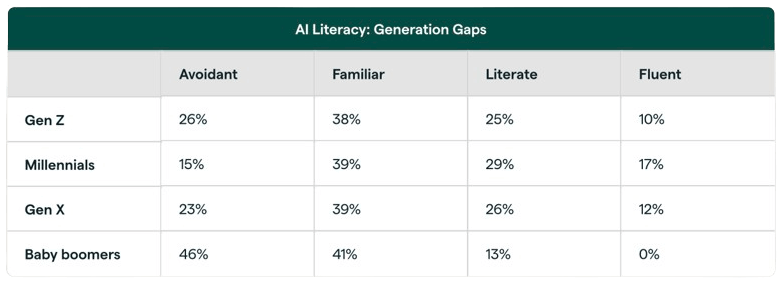
It’s clear that AI experimentation is rampant in the workplace, particularly among younger workers. Notably, Gen Z and millennial generations have embraced AI, with over 80% having at least experimented with AI tools at work. The older generations are far more likely to resist the new technology, with 23% of Gen Xers and a staggering 46% of baby boomers avoiding it altogether.
This rampant experimentation amplifies the urgency and need for AI literacy across the enterprise. If your employees are familiar with AI tools but not using them safely or effectively, it increases the risk for your business. That’s why it is key to invest in proper training and develop formal policies to up-level the skillset of your entire workforce.
Perhaps the most noteworthy AI usage and literacy gaps exist between different teams within an organization. Knowledge workers in sales and customer experience (CX) have been more resistant to adopting AI in their roles. Meanwhile, their colleagues in IT and marketing are mostly literate with AI tools. These gaps must be addressed in order for businesses to reap the benefits of AI enterprise-wide.
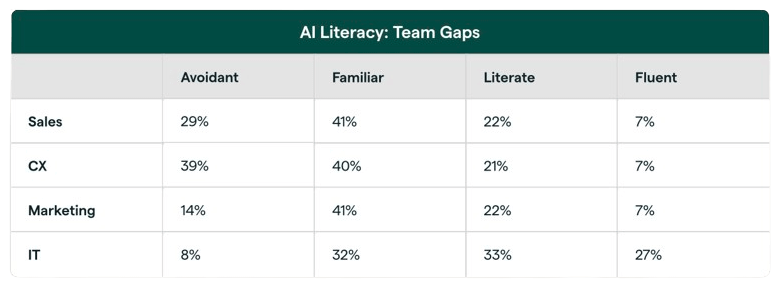
If the usage and literacy gaps go unaddressed, it can lead to inconsistencies in how your business processes are handled and can create bottlenecks in which AI-utilizing departments must wait for others to catch up. For instance, if only the IT department uses AI regularly while other departments such as sales and CX do not, your organization loses out on opportunities for enhanced productivity and innovation. While it’s expected that some teams will adopt AI more quickly, you should aim to ensure that innovation is not siloed but instead used to up-level all teams.
AI literacy vs. data literacy
While AI literacy refers to a deep understanding of AI technologies and the ability to use them effectively, data literacy is the ability to read, understand, create, and communicate data as information. It involves skills in data science, data analysis, interpretation, and critical thinking to make informed decisions. Data-literate individuals, such as data scientists or workers in fields like data analytics or computer science, can gather data, assess its quality, identify patterns, and draw meaningful conclusions. Data literacy is hard to achieve, but AI removes the need for all workers to have this skill since the technology itself has high data literacy.
The importance of understanding LLMs
One critical component of AI literacy is understanding the large language models (LLMs) that AI technology uses to actually generate text. LLMs are trained on vast amounts of data, which allows them to perform the tasks that we ask them to do. There are many different LLMs that are trained on different data sets and fine-tuned to perform certain tasks. Some LLMs may be great at natural language processing, which allows them to generate text when asked a question. Others perform better at coding tasks, and others are better suited for translation assistance.
The foundation of an LLM is its training data. This training data could be vast amounts of public text gathered from the internet or it could be proprietary data sources. Both the volume and the quality of the data that each LLM is trained on impact how that LLM will learn. The more high-quality data, the better the LLM becomes at predicting human language patterns, generating contextual and relevant responses, and performing the specific tasks it’s been fine-tuned to perform.
Two (of many) LLM behaviors to be aware of:
- Biases: If an LLM is trained on unreliable data, such as massive amounts of text data from the internet, which is subject to societal biases, it can reflect or amplify existing prejudices found in its training data.
- Hallucinations: Receiving a seemingly perfectly crafted answer from AI models may sound ideal, but LLMs can create outputs that sound confident and reliable but are actually false or misleading.
Understanding the basics of LLMs is essential to AI literacy because effective use of AI requires you to be aware of its capabilities so that you know when to use certain LLMs for the task at hand. Responsible use of these tools also requires you to be aware of their behaviors so that you can spot potential biases and inaccuracies and actively work to avoid them.
The compounding effect of AI literacy
It’s no surprise that effective communication contributes to both individual and organizational success, but the impact is significantly amplified for those who are comfortable using AI in their workflows. According to The Productivity Shift, AI-fluent workers report significantly higher productivity (96%) and work satisfaction (96%) compared to their AI-avoidant peers (82% and 81%, respectively). The benefits extend to relationships, with 95% of AI-fluent workers reporting improvements in their interactions with colleagues and customers. These findings highlight the powerful synergy between effective communication and AI adoption in the workplace.
AI is transforming workplaces by delivering benefits far beyond improved communication. From boosting productivity (93%) and reducing workloads (91%) to enhancing creativity (91%) and work satisfaction (89%), AI empowers workers to focus on what matters most. Additionally, AI reduces performative communication (86%) and fosters softer skills like empathy (76%), creating an environment where employees can thrive.
The C-suite recognizes that the productivity gains from effective communication and AI amplify business results. The vast majority of C-suite leaders report significant impacts on key outcomes, including increased revenue (90%), higher customer satisfaction (97%), and faster innovation (95%). These results demonstrate how improving communication with AI not only drives workplace productivity but also enhances overall business performance.
Enabling an AI-literate workforce
AI will fundamentally change the way we communicate at work. If your workforce does not invest in AI literacy programs and address these skills gaps, you will be left behind. This is not just a technological upgrade. It’s a fundamental shift in how businesses and employees operate. The learning curve might seem steep, but it is achievable.
Now is the time for leaders to assess their progress toward enterprise-wide AI and invest in ubiquitous AI tools that their entire workforce can leverage. Regular interaction with AI applications can naturally enhance employees’ understanding and comfort with these technologies and foster a more literate workforce. These tools should be embedded into employees’ daily workflows so they can learn to use them in the most productive and effective ways.
When your workforce is comfortable with AI and capable of leveraging a suite of AI tools to drive innovation and efficiency, you will be well on your way to achieving a full business transformation.

